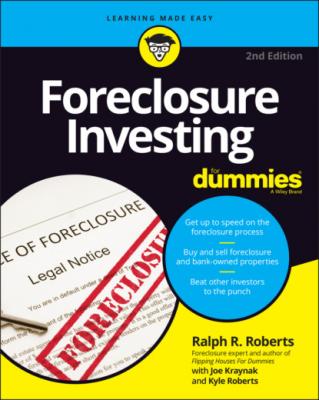Foreclosure Investing For Dummies. Ralph R. Roberts
Читать онлайн.| Название | Foreclosure Investing For Dummies |
|---|---|
| Автор произведения | Ralph R. Roberts |
| Жанр | Недвижимость |
| Серия | |
| Издательство | Недвижимость |
| Год выпуска | 0 |
| isbn | 9781119861003 |
Bankruptcy notices in local papers or legal publications
Divorce filings and decrees in publicly accessible court documents
Foreclosure listing services (websites that list foreclosure and government-seized properties)
Government-owned listings (see a list of links to the top government sites at www.hud.gov/topics/homes_for_sale)
Real estate agents
Attorneys, particularly bankruptcy, divorce, and probate attorneys
Banks and other lenders
Online foreclosure information services range from excellent to total rip-off. Some services deliver timely information; others deliver out-of-date information that’s totally useless. In the beginning, dig up leads the old-fashioned way: through networking and research.
Performing Your Due Diligence
After you find a potentially profitable foreclosure property, the real work begins: performing your due diligence to avoid getting burned. To protect yourself from the many inherent risks of foreclosure investing, dig up the essential facts and figures so that you know what you’re buying and what it’s worth, as well as your options for purchasing the property for less to maximize your profit.
Thorough research requires you to dig up the following essential information:
Names of the homeowners
Amount owed on the property
Lienholder names and contact information
Physical condition of the property
Homeowners’ current situations and motivations
Market value of the property
The following sections introduce you to the types of research to perform as part of your due diligence, but proper research requires much more than I can cover in this chapter. For additional details, see chapter 8.
Investigating the property’s title and other documentation
Before you commit to purchasing a property, you need to know who really owns it, how much the current owners owe on it, to whom they owe the money, how much they owe (if anything) in back taxes, and whether the property has any encumbrances (liens, judgments, or zoning restrictions). In short, you need to know what you’re getting yourself into before you get yourself into it.
Fortunately, most of the following critical documentation about a property is publicly and easily accessible if you’re working with a title company (which I recommend):
Title: The title shows the names of the property owners and lienholders and any legal judgments on the property. I once purchased a property from a mother and daughter, only to discover later that the daughter from whom I bought the property wasn’t the daughter who owned it. The owner daughter eventually took possession of the property, and I was left with some nasty, time-consuming legal battles. By checking the title, you can avoid similar mistakes.
Title history: A title company can provide you with a title history that shows the change of ownership over the years. In some cases, this history reveals gaps in the transfer of the property from one homeowner to the next. A gap in the history may be a warning that someone else can lay claim to the property later and take you to court.
Property history: Your town or city keeps a history of every property, including all building permits issued on the property. If the property has an additional structure that was built without a permit, it may not have been built to code. Any information you can gather about the history of the property can assist you later in evaluating its market value and spotting any red flags.
Inspecting the property with your own eyes
Tattoo the following message on your forehead: My eyes, or no buys. You can look at the title work and other property documents until your eyes cross, but you don’t know the condition of the property unless you see it for yourself. I recommend that you do the following:
Visit the property and the neighborhood it’s in. Never try to assess the value of a property in a vacuum. The condition of the neighborhood affects the sale price.
Walk around the property and inspect it from all four sides. The front of the house can look like the Taj Mahal while the back or sides look more like a bombed-out bunker. See Chapter 8 for additional suggestions on doing drive-by and walk-around inspections.
If possible, get inside and look around. You don’t want to get arrested for trespassing or run off by an angry homeowner, but if the homeowner invites you in, accept the invitation.
See Chapter 8 for more tips on inspecting the property with your own two eyes.
Guesstimating a property's true value
An essential component of successful real estate investing is developing an exit strategy or endgame. Before you agree to pay a certain price for a property, you must have a fairly accurate estimate of what you can sell it for. Otherwise, you risk overpaying and losing money on your investment.
Estimating the market value of a house is easiest with the assistance of
